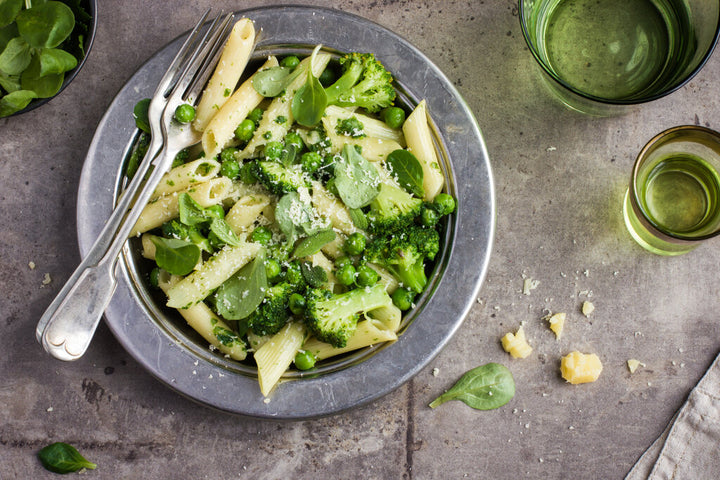When you think of a Dutch oven, you probably think of hearty stews, rich chili, or a perfectly roasted joint of meat. But they're also the perfect vessel for baking everything from bread to cinnamon buns.
If you're new to baking bread in your Dutch oven, this recipe makes a great starting point. It's gluten-free, making it perfect for anyone with a gluten allergy or sensitivity to enjoy!
You'll soon realize that Dutch oven bread is easy to make and looks incredibly professional, and we've also included a simple Dutch oven bread recipe for you to try.
Gluten-Free Dutch Oven Bread - Nutrition Information
In one whole loaf
Calories: 1664 kcal; Fat: 49 g; Cholesterol 327 mg; Sodium: 508 mg; Carbohydrates 280 g; Fiber: 46 g; Sugar: 20 g; Protein: 51 g.
*Numbers are estimates only and vary with different preparations.
Dutch Oven Bread FAQs
Can you proof bread faster with an instant pot?
Waiting for bread to rise is a time-consuming process - if you forget to account for it when planning your cooking time, you might get caught in a bind. If you have an instant pot, you can significantly lower the amount of time you need to let your bread rise or proof.
The yogurt setting on instant pots can provide low, consistent heat, much like the professional proofers that bakeries use.
Instructions for instant pot bread proofing
- Lay dough on a sheet of parchment paper.
- Insert your steaming rack into the instant pot.
- Place the parchment paper containing your dough on top of the steaming rack.
- Securely attach the lid.
- Set the valve to "venting."
- Press the "Yogurt" button on low mode
- Remove dough when it becomes bubbly and sticky.
*The process length may vary between pots, but it took about 24 min for our dough to double.
Can you bake bread in enameled cast iron?
Yes. The size and shape of enameled cast iron Dutch ovens make them perfect for baking bread.
Their tight-fitting lids, which can be left on during the baking process, trap steam within the pot. Trapping the steam will give you the perfect shiny crust every time.
For the best results, you'll want to preheat your Dutch oven before placing your dough inside. This will ensure that as soon as the baking process starts, steam will be created from the moisture in the dough without waiting for the pot to warm.
You'll find that home-cooked bread cooked in an enameled cast iron Dutch oven will turn out looking like a loaf from the artisan bakery, with a beautifully airy and fluffy interior topped by a golden crust with the crunch and crackle you'd expect from a professional bakery's bread.
With cast iron, bread dough, and the right amount of time, you'll be baking the best-looking and tasting bread you've ever tried.
How do you keep the bread from sticking to a Dutch oven?
If you find that your dough is sticking to the interior surface of your Dutch oven, or it's proving difficult to remove once baked, causing tearing, you can remedy this by preparing the surface before use, or you can line your Dutch oven with parchment paper.
Coat the inside with a thin layer of vegetable oil using a paper towel or pastry brush, or use an oil spray to cover the interior evenly. Once you have covered the inside with oil, sprinkle a small amount of cornflour or semolina flour around the sides and bottom of the pot.
You may find that this causes a small amount of smoking as you bring the pan up to temperature - don't worry, that's normal. If there's a significant amount of smoke, you may want to ensure you haven't over oiled the surface, added too much flour, or added it in a way that caused it to form clumps.
How to bake bread in a Dutch oven?
Our favorite Dutch oven bread recipe is simple enough for beginners but will consistently produce beautiful bread that is sure to wow your friends and family.
This is a no-knead gluten-free bread recipe. If you don't know how to make bread dough already, this is a great introduction, as it doesn't require the extensive kneading which many other types of bread do (and that's the hardest part!)
Final Notes on Dutch oven bread baking
Once you've mastered the basics of baking bread, there is a whole range of Dutch oven recipes out there for you to try. Beyond no-knead sourdough bread and gluten-free no-knead loaves, you can get started with kneading your own dough - it's tough at first but opens you up to even more bread-baking options (and a great forearm workout!).
You can experiment with adding toppings to your loaves, such as seeds, grains, or even cheeses.
You can also add ingredients to the dough itself to make fruit bread or flavored loaves.
If you're looking for something sweeter, we suggest checking out our Dutch oven Monkey bread recipe.
There are hundreds of combinations for baking bread to try out with your Dutch oven - the possibilities are there to be explored and enjoyed!
Leave a comment
Comments will be approved before showing up.
Also in Recipes










